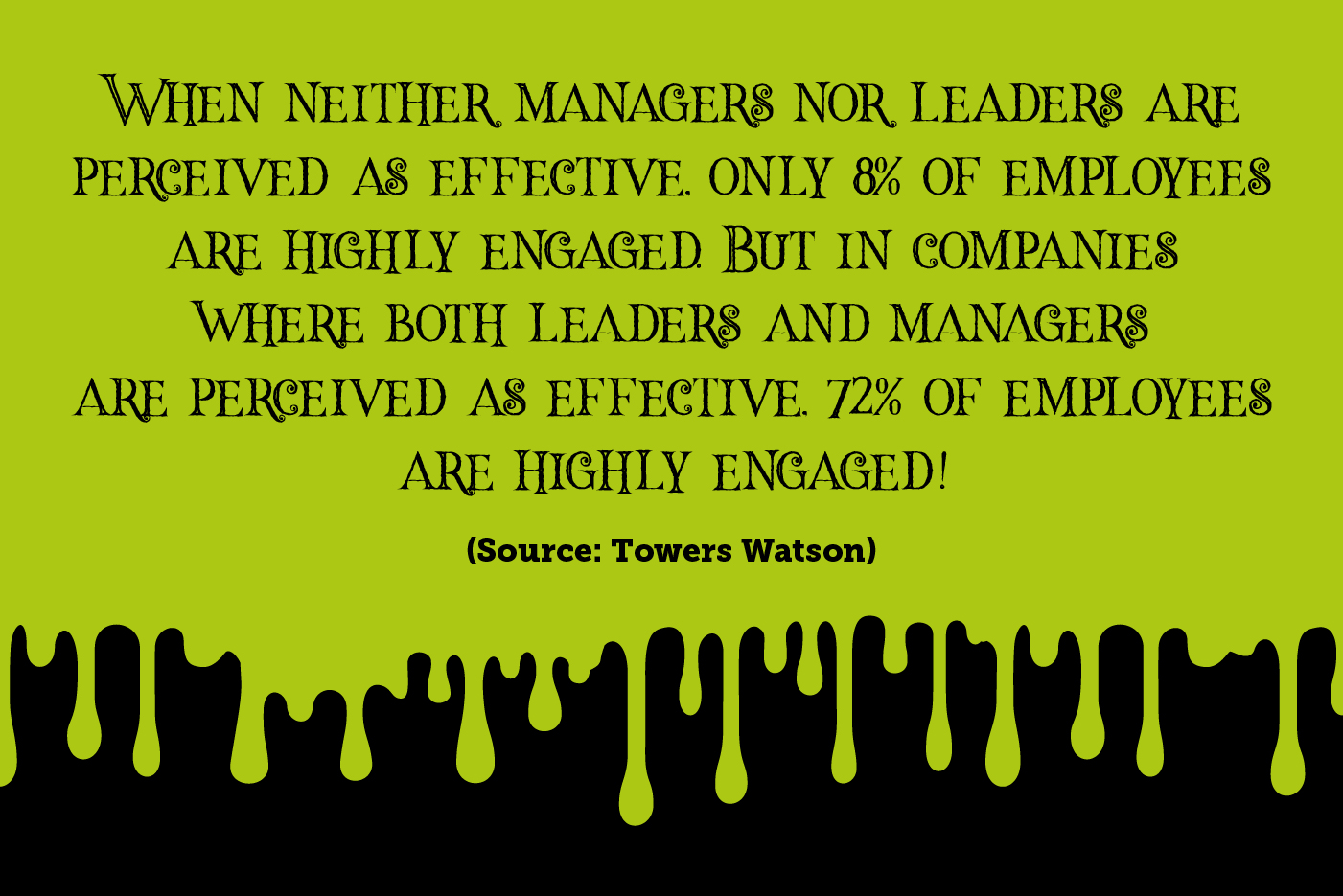
As ghosts, demons and all manner of monstrous creatures emerge from the shadows for Halloween, we get to grips with some ghastly ghouls of our own – and explore 6 horror stories of poor leadership in the workplace from the silver screen that will make employees everywhere shudder with fear!
We wonder if you’ve ever come across the infamous adage, ‘people don’t quit their jobs; they quit their bosses’?
Maybe you’ve even contemplated jumping the career ship yourself once or twice thanks to bad workplace leadership (or perhaps you’ve actually taken the leap!).
While the accuracy of that oft-quoted statement has been thrown into question, there can be no doubt that our leaders’ management styles play a big role in inspiring us to go above and beyond the call of duty, or encouraging us to take the first new job offer we happen across just so we can get as far away from them as possible.
The problem of poor workplace leadership

The reality though, is that poor leadership is unfortunately all too common a problem. In fact, as many as 1/3 of employees think their leader has a negative impact on the company culture.
Quite apart from the werewolves, zombies and witches you’re likely to find appearing on your doorstep today – it’s this that will be keeping disengaged employees up at night.
The good thing is that every cloud has a silver lining, and for every example of bad leadership in real life, there’s a satirical fictitious counterpart to poke fun at it and expose the underlying issues for all to see.
So for a bit of Halloween fun, we’ll be treating (or maybe that should be tricking) you to some of the ghastliest, terrifying leadership horror stories from the silver screen – and exploring what they can tell us about how leadership should really be done.
You may have even experienced situations like these over the course of your career (although hopefully not to these extremes!).
Got your Halloween candy at the ready? Then we’ll begin…
6 horror stories of poor leadership in the workplace
When you’re violently assaulted for airing your view
If one of your employees happens to vocally disagree with something you’ve said, without a doubt one of the absolute worst ways to respond is by attempting to choke them to death. Unfortunately though, Darth Vader didn’t get the memo.
When Admiral Motti boldly contradicts his superior’s remark that the Death Star’s weaponry isn’t a patch on the Force, rather than settling the conflict of opinion in a productive, civilised manner – Vader wastes no time in demonstrating his point by force-choking the poor guy. Just in case the message wasn’t clear enough.
Granted, Motti didn’t put his point forward in the politest of ways, but it still goes without saying that using force (even if it isn’t the mystical one) to resolve disagreements is not the way to go.
Good leaders encourage all voices to be heard, and promote open, honest and inclusive debate. After all – isn’t that where the best ideas come from?
(As a bonus treat, we love this clip from Robot Chicken which hilariously pokes fun at this exact scene from the film):
When your manager is totally and utterly inept
‘Belief in senior leadership’ is one of the strongest drivers of employee engagement. With this in mind, we think it’s safe to say that the poor employees of Wernham Hogg never stood any chance of being engaged.
Despite his best intentions, David Brent is a leader who just falls flat on his face at every hurdle, unable to inspire confidence or trust in any of his long-suffering staff.
Maybe it’s his misguided mantra that he’s ‘a friend first, and a boss second. Probably an entertainer third’ (a well-meaning philosophy that he takes as an invitation to be an annoying, distracting clown). Perhaps it’s the pretentious, self-important attitude that spills out from everything he does. Or maybe it’s his appalling communication skills, which leave a whole lot to be desired. Or it could just be his total lack of competence in basically everything he turns his hands to.
Especially in times of uncertainty and change, employees look to senior leaders for reassurance, support, and guidance. And leaders need to have the confidence and capability to step up to the plate.
Even if you don’t have all the answers, simply embodying solidarity and conviction – and communicating a strong, inspiring vision – will go a long way in boosting employee morale.
When you’re never, ever recognised for your hard work – or at all
It’s true that Homer Simpson wasn’t the best employee on the block – a lifetime of falling asleep at his Nuclear plant control desk and stuffing his face with donuts on the job is solid proof of that.
But it’s also fair to say that Mr Burn’s wasn’t the most inspiring, motivational boss in the books either.
The Simpsons’ answer to Scrooge is a mean-spirited, greedy, self-serving, finger-steepling plutocrat who cares little for the well-being and happiness of his employees, just so long as they’re helping to keep his counting house well-stocked. Perhaps the most telling thing is that he doesn’t even attempt to remember any of their names.
All we can say is that it’s really no wonder that Homer, Lenny and Carl are serial slackers who don’t really care about doing their jobs well – since Mr Burns never once returns the favour.
93% of employees who feel valued are motivated to do their best – but this amounts to just 34% of employees who don’t feel valued by their leaders.
Showing that you appreciate your employee’s efforts doesn’t have to just be about pay rises and promotions. Simply shining the spotlight on them in return for diligence and commitment – is enough to keep engagement and motivation on the up.
When you become the butt of inappropriate behaviour
There’s a scene from the Friends episode ‘The One with the Ultimate Fighting Champion’ where Chandler literally becomes the ‘butt’ of his manager’s inappropriate behaviour – whereby the latter repeatedly spanks him on the… erm, butt… as a way of saying ‘job well done’.
Needless to say, when we mentioned the need to show appreciation to employees in our last point, this isn’t exactly what we meant.
Clearly, while this scene is played for laughs, inappropriate behaviour of any kind by leadership figures is totally unacceptable.
The good thing about this particular portrayal though is that when Chandler reveals his discomfort at being on the receiving end of this unusual recognition technique, his manager graciously accepts his viewpoint, and alters his behaviour accordingly.
It’s common sense, but 75% of employees would stay longer in a business where they were listened to and had their concerns addressed. And ‘being ethical and fair’ ranks as the 3rd most important quality of a perfect leader.
A truly inclusive leader allows every employee to share their concerns and opinions, and make their voices heard. And beyond that, they actively take what’s raised on board – and make appropriate changes to suit.
When you’re subject to bullying and constant criticism
(Warning: contains strong language)
The infamous spin doctor from political-satire series The Thick of It – Malcolm Tucker – is quite possibly one of the best examples there is of poor leadership in the workplace quite literally turned all the way up to 11.
Not averse to frequently using Machiavellian techniques to achieve his often morally dubious aims, Tucker rules with an iron fist, preferring to bully, scare and criticise his colleagues into submission rather than positively inspiring them to achieve results – often with a tirade of expletives to boot.
His unruly leadership techniques do nothing but sow seeds of discontent among his peers, accumulating him a host of enemies and a significant lack of allies – hardly a good retention strategy.
Leaders can’t expect to win the support of their workforce if they treat employees with disdain and contempt. An aggressive ‘my way or the high way’ attitude just breeds resentment.
Employees will be much more motivated to go above and beyond in a positive culture where they’re supported and inspired – not treated as the underlings of a ruthless enforcer.
When your health and safety is completely swept under the carpet
(Warning: Contains moderate violence)
If you’ve seen the movie Nightcrawler (BIG SPOILER INCOMING), you’ll know that what starts out as a well-meaning, supportive (if unorthodox) leadership style from criminal-turned-businessman Lou Bloom towards his assistant Rick takes a nasty turn – when Lou intentionally leads him into a life-threatening situation at the film’s climax, with no regard for his health or safety.
We thought we’d end on this leadership horror story because if there’s one thing a leader must absolutely, definitely, never ever EVER do – it’s to put the life of their employees at risk for the misguided ‘good’ of the company. Although you probably don’t need us to tell you that.
You’ll likely have noticed the common theme woven throughout these ghoulish horror stories of poor leadership in the workplace. That truly effective leadership means putting yourself on a level playing field with employees.
It takes an open-minded, supporting culture. It takes positive inspiration, encouragement, and confident capability. It takes consistent recognition and appreciation.
And most importantly, it takes kindness, humility, and genuine fairness.
To finish, we’ll leave you with this revealing treat of a statistic:

Oh, and one last thing…













